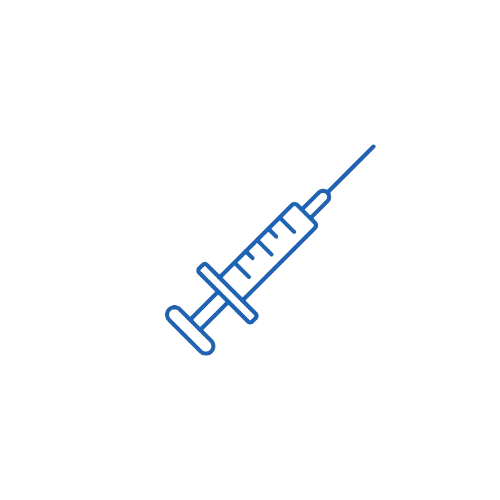Bortezomib
Indications
Approved Indications:
- Multiple Myeloma:
- For previously untreated patients, in combination with melphalan and prednisone.
- As monotherapy or in combination with dexamethasone for relapsed or refractory multiple myeloma.
- Mantle Cell Lymphoma (MCL):
- For patients with relapsed or progressive disease after at least one prior therapy.
Off-label / Clinically Accepted Uses:
- Systemic AL Amyloidosis: Used as part of chemotherapy regimens in patients with light chain (AL) amyloidosis.
- Waldenström Macroglobulinemia: In select relapsed or refractory cases.
- Non-Hodgkin’s Lymphomas: In investigational or refractory scenarios.
Dosage & Administration
Administration Route: Intravenous (IV) or subcutaneous (SC) injection.
Adults – Multiple Myeloma:
- Initial dose: 1.3 mg/m² twice weekly on Days 1, 4, 8, and 11 of a 21-day cycle.
- Subsequent cycles: Dosing schedules vary based on combination therapy and patient response.
Mantle Cell Lymphoma:
- Recommended dose: 1.3 mg/m² administered twice weekly for two weeks (Days 1, 4, 8, and 11) followed by a 10-day rest period (21-day cycle).
Pediatrics:
- Not FDA-approved; investigational dosing may apply in clinical trials under strict oncological supervision.
Elderly:
- No specific dose adjustment required based solely on age. Monitor closely for peripheral neuropathy and other toxicities.
Renal or Hepatic Impairment:
- Renal: No initial dose adjustment necessary.
- Hepatic:
- Mild impairment: No adjustment.
- Moderate to severe impairment (bilirubin >1.5x ULN): Start with reduced dose of 0.7 mg/m² in the first cycle; consider escalation if tolerated.
Mechanism of Action (MOA)
Bortezomib is a reversible inhibitor of the 26S proteasome, a large protease complex responsible for degrading ubiquitinated proteins within cells. By inhibiting this proteolytic pathway, Bortezomib disrupts multiple intracellular signaling cascades, leading to accumulation of pro-apoptotic factors and inhibition of NF-κB activation. The result is enhanced tumor cell apoptosis, especially in malignant plasma cells and lymphocytes which are more sensitive to proteasome inhibition due to their high turnover and metabolic activity.
Pharmacokinetics
- Absorption: Rapid following IV administration; subcutaneous route leads to slower peak concentration but similar exposure (AUC).
- Bioavailability: High with IV; SC bioavailability is comparable (~70–100%).
- Distribution: Widely distributed; plasma protein binding ~83%.
- Metabolism: Primarily hepatic via CYP450 enzymes (CYP3A4, 2C19, 1A2).
- Elimination Half-life: Approximately 40–190 hours; prolonged with repeated dosing.
- Excretion: Mainly via hepatic metabolism; excreted in bile.
Pregnancy Category & Lactation
- Pregnancy Risk: Not assigned (previously Category D).
- Bortezomib may cause fetal harm based on animal data; contraindicated in pregnancy.
- Lactation: Unknown if excreted in human milk; due to potential for serious adverse reactions in infants, breastfeeding is not recommended during therapy and for 2 months after the last dose.
- Recommendation: Use effective contraception during treatment and for at least 7 months after the final dose (females) and 4 months (males).
Therapeutic Class
- Primary Class: Antineoplastic Agent
- Subclass: Proteasome Inhibitor
- Generation: First-generation reversible 26S proteasome inhibitor
Contraindications
- Known hypersensitivity to Bortezomib, boron, or mannitol
- Intrathecal administration (fatal cases reported)
- Severe hepatic impairment (relative contraindication without dose adjustment)
Warnings & Precautions
- Peripheral Neuropathy: May be severe; monitor closely; consider dose reduction or discontinuation.
- Hematologic Toxicity: Thrombocytopenia and neutropenia are common; frequent CBC monitoring required.
- Cardiac Effects: Risk of heart failure, arrhythmias, and hypotension; caution in patients with existing heart disease.
- Pulmonary Toxicity: Rare interstitial lung disease or acute respiratory distress.
- Herpes Zoster Reactivation: Prophylactic antiviral therapy recommended.
- Tumor Lysis Syndrome: Risk in patients with high tumor burden.
- Hepatic Toxicity: Hepatic failure, including fatal cases, reported.
- Posterior Reversible Encephalopathy Syndrome (PRES): Monitor for seizures, confusion, or visual disturbances.
Side Effects
Common:
- Neurological: Peripheral neuropathy, paresthesia
- Gastrointestinal: Nausea, vomiting, diarrhea, constipation
- Hematologic: Thrombocytopenia, neutropenia, anemia
- General: Fatigue, fever, anorexia
Serious:
- Heart failure, arrhythmias
- Pulmonary complications (dyspnea, pneumonitis)
- Hepatic failure
- PRES
- Hypotension and syncope
- Herpes zoster reactivation
Rare:
- Stevens-Johnson syndrome
- Tumor lysis syndrome
- Pancreatitis
Drug Interactions
- Strong CYP3A4 Inhibitors (e.g., ketoconazole): May increase Bortezomib exposure and toxicity.
- CYP3A4 Inducers (e.g., rifampin, carbamazepine): May reduce efficacy.
- Antihypertensives: Additive hypotension possible.
- Vaccines: Avoid live vaccines during treatment due to immunosuppression.
- NSAIDs and Anticoagulants: Increased bleeding risk, especially with thrombocytopenia.
Recent Updates or Guidelines
- EMA & FDA: Recommend SC over IV route due to reduced neuropathy risk without compromising efficacy.
- NCCN Guidelines (Latest): Continue to recommend Bortezomib as part of frontline and relapsed myeloma regimens (e.g., VRd - bortezomib, lenalidomide, dexamethasone).
- Updated Dosing Adjustments: More refined guidance for patients with hepatic impairment.
Storage Conditions
- Unreconstituted Vials:
- Store at 2°C to 8°C (Refrigerate; Do Not Freeze)
- Protect from light; store in original carton.
- Reconstituted Solution:
- IV Preparation: Stable for up to 8 hours at 25°C.
- SC Preparation: Use within 8 hours; do not refrigerate.
- Do not shake; gently swirl for mixing.
